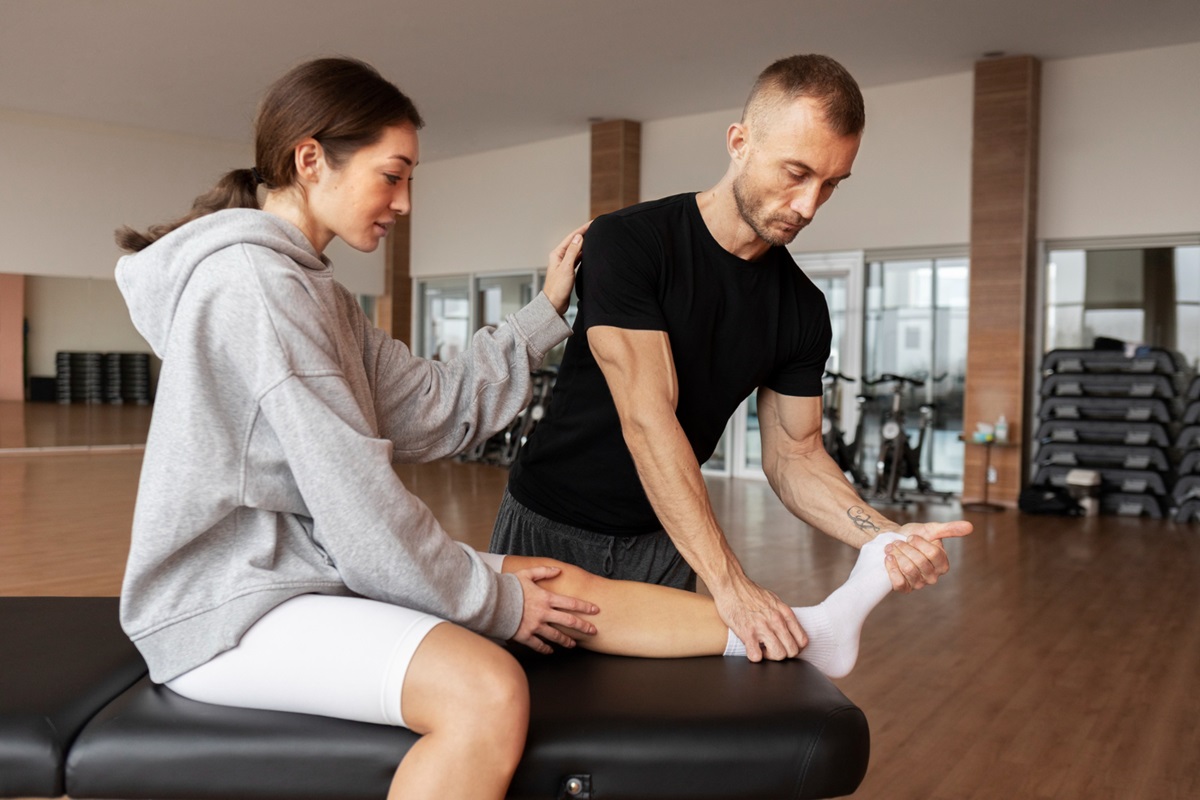Understanding the difference between Achilles bursitis vs tendonitis is critical for anyone experiencing heel or ankle pain. These two conditions, although similar in symptoms, have different causes, locations of inflammation, and treatment protocols. A proper diagnosis helps you address pain and swelling effectively, especially if you’re experiencing Achilles pain when running or during your daily activities.
What Is Achilles Bursitis vs Tendonitis?
Achilles bursitis vs tendonitis often gets confused due to overlapping symptoms. However, recognizing the key differences between them can significantly improve your approach to healing. Inflammation of a tendon, such as the Achilles tendon, presents differently than inflammation of a bursa, like the retrocalcaneal bursa found near the heel bone.
Quick Definitions and Key Differences
Achilles bursitis refers to inflammation of the retrocalcaneal bursa, a fluid-filled sac that provides joint cushioning between the Achilles tendon and the calcaneus (heel bone). It is often caused by excessive friction, tight or ill-fitting shoes, or structural problems such as Haglund’s deformity. On the other hand, Achilles tendonitis involves inflammation of the Achilles tendon itself, often due to overtraining, repetitive motion, and improper conditioning.
The location of inflammation in Achilles tendon bursitis is typically deeper and results in pain at the lowest point of the heel, while tendonitis results in stiffness over the tendon and pain above the heel bone. Both may cause visible swelling, but the intensity and source can help distinguish between the two.
Why Accurate Diagnosis Is Critical
A thorough diagnosis is essential to create an effective treatment plan. Clinicians typically conduct a history and physical exam, evaluate pain location, perform physical assessment and special testing, and may use imaging techniques such as x-ray, ultrasound, or MRI to differentiate Achilles bursitis vs tendonitis. Incorrect diagnosis could result in ineffective treatment or worsening of symptoms, particularly in the presence of complications such as Haglund’s syndrome or tendon tear.
Symptoms and Causes
Both Achilles tendon bursitis and Achilles tendonitis cause discomfort and hinder movement, but understanding their unique symptoms can clarify the root issue. These conditions often stem from overuse of the ankle and foot, especially among runners, hikers, and athletes.
Common Symptoms of Achilles Bursitis
- Pain at the back of the heel, especially when putting pressure on it or wearing shoes
- Swelling in the affected area due to inflammation of the retrocalcaneal bursa
- Redness and warmth in the region of the bursa
- Pain on the heel when wearing shoes, often exacerbated by tight footwear or Haglund’s deformity
- Stiffness or tenderness in the affected area, leading to reduced ability to walk or run
Common Symptoms of Achilles Tendonitis
- Pain and stiffness along the Achilles tendon, especially after rest or early in the morning
- Pain that is worse with activity or repetitive motion such as running or hiking
- Swelling severity increases over time, with thickening of the tendon in some cases
- Limited ankle range of motion and muscle weakness due to tendon inflammation
Shared Risk Factors and Triggers
- Overuse of the ankle through high-impact activities or prolonged periods of activity
- Improper conditioning, especially when returning to exercise after a break
- Structural problems such as flat feet or high arches
- Shortened calf muscles leading to increased strain on the Achilles tendon
- Tight or ill-fitting shoes creating excessive pressure at the back of the heel
- Haglund’s deformity increasing friction near the insertion point of the Achilles tendon
- Increase in duration and intensity of exercise without proper progression
- Excessive repetitive motion causing chronic irritation to bursae and tendons
Achilles Tendon Bursitis Treatment Options

Achilles tendon bursitis treatment requires a comprehensive strategy to address both symptoms and root causes. While home remedies can manage early signs, persistent cases often need professional intervention.
Home Remedies and Conservative Care
For Achilles bursitis treatment, consider:
- Rest to reduce inflammation and allow healing of the bursa
- Ice therapy to alleviate visible swelling and pain at the back of the heel
- Non-steroidal anti-inflammatory medication to control pain and swelling
- Custom orthotics to correct biomechanical issues and reduce excessive pressure at the back of the heel
- Heel lifts or proper shoes to reduce friction and support the heel
- At-home stretches and exercises, including toe stretch and foot and ankle up down movements to enhance flexibility
- Gradual progressive stretching programs to lengthen shortened calf muscles
- Myofascial release techniques to decrease soft tissue tension
When to Seek Professional Treatment
If conservative care fails to improve symptoms, professional support is advised. Speak with a PT (physical therapist) to undergo advanced treatments such as:
- Manual therapy and physical therapy tailored to the individual
- Bracing to offload strain from the Achilles tendon and bursa
- Ultrasound or shockwave therapy to promote healing of retrocalcaneal bursitis
- Corticosteroid injections, used cautiously, to reduce inflammation in the bursa
- Aspiration or antibiotics in cases of infectious bursitis
- Surgical options like bursectomy in chronic or non-responsive cases
At Backcountry Physio, we specialize in treating conditions like Achilles tendon bursitis with custom rehabilitation programs that target both symptoms and underlying causes.
Following treatment, physical therapy may be essential for restoring mobility and function. It’s equally important to guide patients in avoiding the repetitive activities or stressors that initially led to the development of bursitis.
Achilles Tendonitis Treatment Essentials
Achilles tendonitis requires a structured rehabilitation approach to reduce inflammation and restore function. As tendonitis involves direct tendon inflammation, treatments focus on strengthening, mobility, and tissue regeneration.
Exercises, Support, and Modalities
Effective Achilles tendonitis treatment strategies include:
Skilled physical therapists play a critical role in helping individuals recover from Achilles tendinopathy. By creating personalized exercise plans, they target tendon strength, enhance flexibility, and correct underlying biomechanical imbalances that may contribute to the condition.
- Achilles tendinitis stretches and exercises to improve flexibility and reduce tendon strain
- Eccentric strengthening exercises to promote tendon healing
- Foam rolling and myofascial release for adjacent muscle groups
- Supportive bracing or taping to reduce strain during movement
- Electrical stimulation or ultrasound therapy to manage inflammation
- Exercise and stretching programs that account for training frequency and intensity
- Custom orthotics for alignment correction
Advanced or Surgical Options
For severe or persistent cases, advanced interventions may be necessary:
- Platelet-rich plasma (PRP) therapy to enhance healing through growth factors
- Corticosteroid injections, though used sparingly due to the risk of tendon weakening
- Surgical intervention for tendon tear, including tendon repair or debridement in cases of insertional Achilles tendinitis
- Iliotibial band release if tightness contributes to abnormal loading on the Achilles tendon
The choice of intervention depends on the pain location, swelling severity, and the overall clinical picture revealed by physical assessment and diagnostic tools.
Preventing Achilles Injuries
Preventive strategies can help avoid the recurrence of Achilles tendon bursitis or Achilles tendonitis. By making small adjustments to your routine, you can significantly reduce your risk.
Smart Training and Footwear Choices
- Gradually increase training intensity and duration to avoid overtraining and excessive repetitive motion
- Use proper shoes with adequate cushioning and support to minimize excessive friction and pressure
- Choose shoes that prevent pain on the underside of the heel and reduce irritation near the Achilles insertion
- Avoid running on hard surfaces and incorporate cross-training to reduce stress
Stretching and Strengthening Routines
- Regular toe stretch and calf muscle stretches to lengthen shortened calf muscles
- Achilles tendon bursitis stretches and exercises to maintain joint mobility and flexibility
- Balance drills and proprioceptive exercises to prevent overuse injuries
- Strengthening exercises targeting the foot and ankle up down movement patterns
Why Backcountry Physical Therapy Is Trusted for Achilles Care

Backcountry Physical Therapy has a proven track record in treating Achilles tendon bursitis, Achilles bursitis treatment, and Achilles tendonitis. Our approach focuses on identifying your unique risk factors and providing an effective, results-driven recovery plan.
Expert Diagnosis and Individualized Plans
We provide comprehensive diagnosis through history and physical exam, imaging tools like ultrasound or MRI, and special testing to identify the correct pain source—be it tendonitis, retrocalcaneal bursitis, or Haglund’s syndrome. Our individualized plans include targeted rehabilitation, conditioning programs, and manual therapy techniques for lasting results.
In-Person and Virtual Physiotherapy Options
Whether you’re managing Achilles pain when running or recovering from insertional Achilles tendinitis, Backcountry Physio offers both in-person and virtual therapy options. Speak with a PT to receive a customized treatment plan and get back to your outdoor adventures, pain-free and stronger than ever.
Conclusion
Understanding Achilles bursitis vs tendonitis allows for accurate diagnosis and targeted treatment. Both conditions cause heel pain, but differ in location of inflammation and healing strategies. By investing in preventive care and expert treatment from providers like Backcountry Physio, you can regain your stride and minimize future setbacks.
FAQs
Will Achilles bursitis ever go away?
Yes, Achilles tendon bursitis can go away with proper Achilles tendon bursitis treatment, which includes rest, bracing, physical therapy, and stretching. Chronic cases might require aspiration or even a bursectomy if left untreated.
What is the fastest way to cure bursitis?
The fastest way to cure Achilles tendon bursitis includes rest, physical therapy, proper shoes, shockwave therapy, and anti-inflammatory treatments. Speak with a PT to ensure the treatment plan is tailored to your specific condition.
What are 3 symptoms of bursitis?
Swelling in the affected area, such as the retrocalcaneal bursa, Pain at the back of the heel, especially when under pressure or wearing shoes, Redness and warmth in the area due to inflammation.



